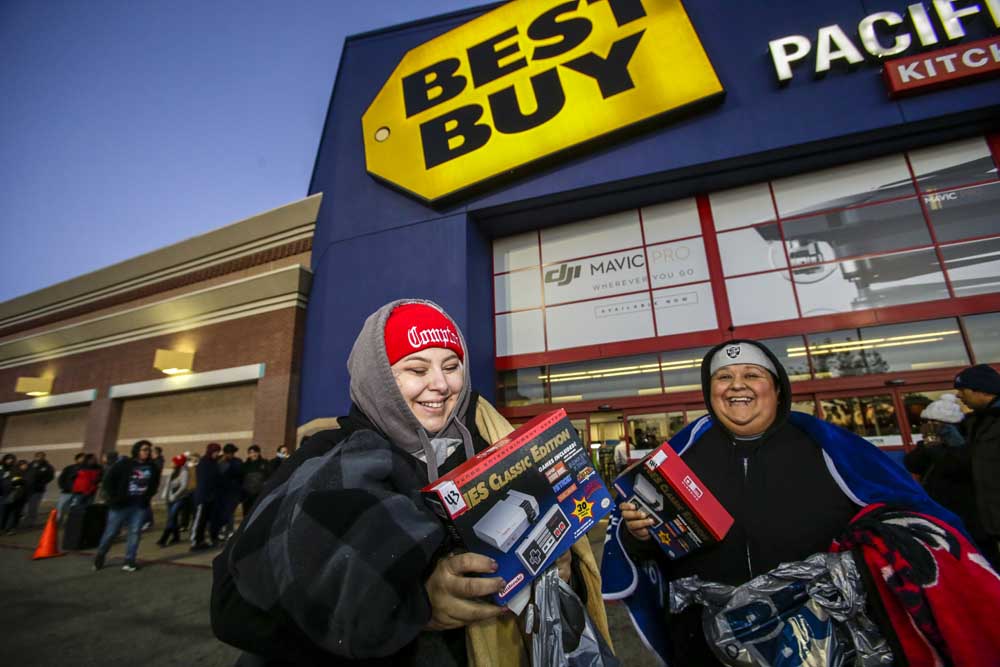Holiday toy hype
Published 12:00 am Friday, December 23, 2016

- Sisters Lori Ramirez, left, and Paula Rubalcaba waited in line overnight to purchase one of only 57 units of retro-looking Nintendo NES Classic, made available at a Best Buy in Atwater, California, on Wednesday. (Irfan Khan/Los Angeles Times/TNS)
LOS ANGELES — Every holiday season, there’s a must-have toy — a Hatchimal or Tickle Me Elmo that kids covet and frantic parents will do anything to find. Its scarcity drives many to stand in line for hours or pony up hundreds of dollars to scalpers, all the while asking: Why can’t toy companies just make more?
It’s not for lack of trying.
Trending
A breakout toy can be crucial to the $25 billion toy industry, with some companies pulling in 40 percent or more of their annual sales during the last two months of the year. But guessing the next hit is notoriously difficult.
Nervous about overproducing toys that wind up being flops, toymakers often release new products in limited supply. But because of the complexity of the global supply chain, ramping up production isn’t always easy.
The result: a holiday hype cycle in which demand creates buzz that fuels even more demand.
Toy companies and retailers often find themselves sprinting after a runaway winner, hurriedly ramping up production and even bringing on additional factories in the weeks before Christmas. Interest in hot toys usually lasts for 12 to 18 months, meaning that companies must act quickly.
“Toys is absolutely a fashion business,” said Richard Barry, global chief merchandising officer at Toys R Us. “It is very, very high fashion in the sense that things come and they go.”
Among this year’s blockbusters are Hatchimals — furry animals that peck themselves out of an egg. After they hatch, they interact with humans, learn to walk, talk and even play games.
Trending
Toys R Us spotted the appetite for Hatchimals when they launched in early October and placed additional orders with Spin Master, the Toronto company behind the toys, Barry said. Even with that quick reaction, he said, expanding production of these kinds of electronic toys is tricky.
At Spin Master, the company went into “high gear” upon seeing a huge initial response, spokeswoman Tara Tucker said. The factory in China that produces Hatchimals began cranking up production.
“We knew we needed to act on it,” Tucker said. “We did everything from trains and air freight as well as increased production immediately.”
Many retailers, including Toys R Us, have gotten additional shipments, but stock has quickly sold out. On eBay, Hatchimals sell for as high as $1,200 (they typically retail for $60 to $80).
Nintendo, which also has a hit with the retro NES Classic Edition game console, said it too has been increasing production after a surprisingly big response. The research firm NPD Group recently said Nintendo sold nearly 200,000 units in its first month, outpacing sales of its Wii U console.
Manufacturers and retailers alike benefit from shoppers’ frenzied searches. In the run-up before Christmas, many chains sell only what little stock they have in brick-and-mortar locations, using it as a lure to draw people into stores. Some toymakers purposely hold back supply in an effort to drum up attention and incite a potential sales boost once more are released post-holidays, analysts said.
“There is artificial scarcity,” said Craig Johnson, president of research firm Customer Growth Partners. That’s when “people create a shortage and make it seem like it’s hot. Meanwhile, they have a gazillion of them sitting in a warehouse.”
But there’s actual scarcity too. It can afflict companies with complex products, analysts said, or firms caught totally by surprise when an unlikely plaything achieves must-have status.
“Sometimes, there is no rhyme or reason to it,” Johnson said. “You go back long enough, the hot toy was a pet rock.”








